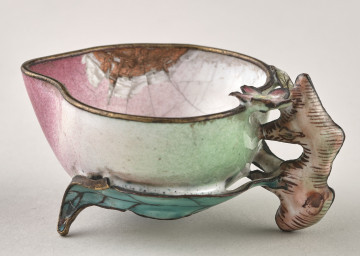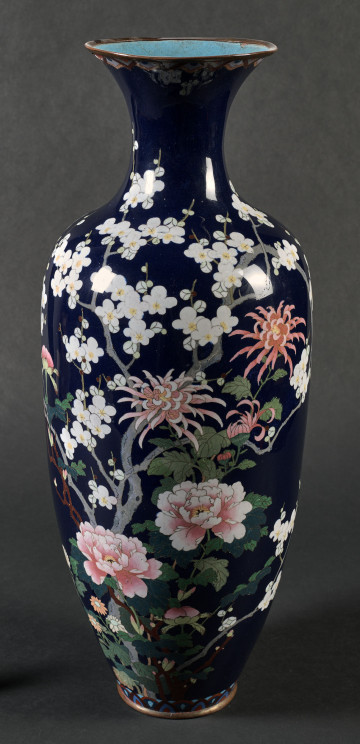
Bowl
18th-19th century
Castle Museum in Łańcut
Part of the collection: Orient
A massive bronze columned censer, consisting of five elements – moduses. Base in the form of a dog/lion Fo. The upper part of the shaft resembles a tree branch with a dragon climbing around it. At the top, there is the figure of a seated lohan – a monk – supporting a bowl on his head and shoulders. The shaft in the central and lower part is decorated in relief with a motif of lotus petals, fantastic birds, flying geese, monkeys, flowers, mythical feng – huang birds. The dog is shown standing, on widely-spaced paws, with clawed feet. The animal has open muzzle, covered with floral and volute ornamentation. Censer is a vessel designed to burn incense or perfume in solid form. They had typically utilitarian nature in many cultures since the ancient times. They were used to purify the air of pathogens in the event of an epidemiological emergency, for ritual ceremonies and prayers, to perfume rooms and even to measure time during rituals and ceremonies, when the progress of burning cone incense was measured. The incense sticks are burned by placing them directly on a heat source or on a hot metal plate in a censer. The Fo lions – a very common motif in Chinese art – were mythical guardians of Buddhist temples, imperial palaces, tombs. They were attributed with special powers, above all protection from demons. This motif appears in monumental sculpture as well as in the form of small ceramic figurines decorating residential interiors, especially eagerly collected in Europe at the time of increased interest in the Orient. Lions did not occur on Chinese territory, so the grotesque appearance of the animals depicted in the sculpture may be the result of imagination and fantasy. The artists may also have been inspired by the shih-tzu dogs, known as “lion dogs”, which were bred in temples and at the imperial court at the time.
Author / creator
Dimensions
height: 169 cm
Technique
fine detail finishing, cast
Material
gold, bronze
Creation time / dating
Creation / finding place
Owner
Castle Museum in Łańcut
Identification number
Location / status

18th-19th century
Castle Museum in Łańcut

19th (?) century
Castle Museum in Łańcut

18th-19th century
Castle Museum in Łańcut
DISCOVER this TOPIC
Castle Museum in Łańcut
DISCOVER this PATH
Educational path